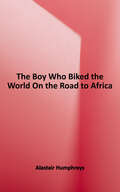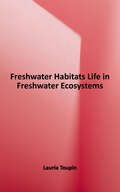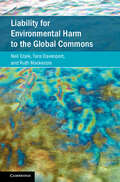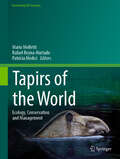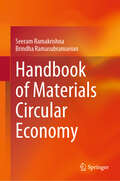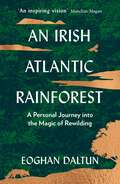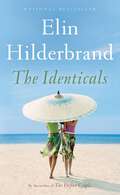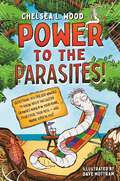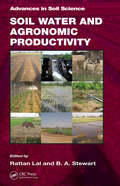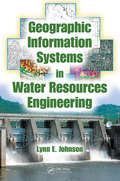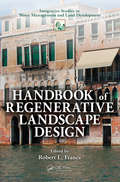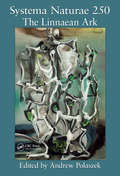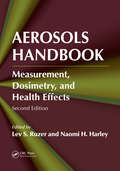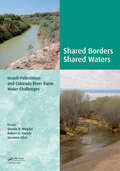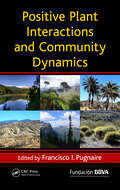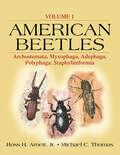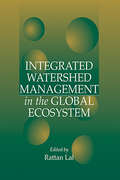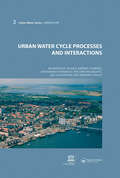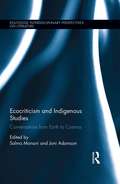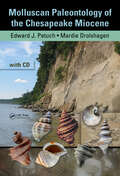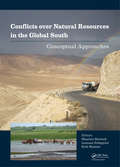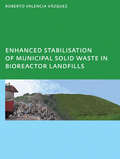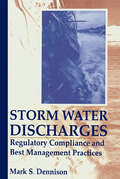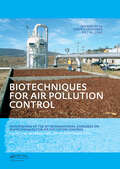- Table View
- List View
The Boy Who Biked the World: Part One: On the Road to Africa
by Alastair HumphreysAges 9 – 12 years Discover Africa by bicycle in book 1 of a delightful children's adaptation of Alastair Humphrey's journey around the world. In this charming caricature of Alastair Humphreys' infamous circumnavigation of the world on his bike, children are swept along with the character of Tom, an adventurous boy who feels there must be more to life than school. The first part of The Boy Who Biked the World follows Tom leaving England, cycling through Europe, and Africa to the tip of South Africa. Along the way, young readers are introduced not only to the various fascinating landscapes he passes through, but also to the various people who so happily embrace him as he traveled on his journey. With engaging illustrations, postcards, and journal entries throughout, this book provides an immersive experience for any young adventurer.
Freshwater habitats : life in freshwater ecosystems
by Laurie ToupinA look at the plants, animals, locations, and various habitats that make up the freshwater ecosystems of the world.
Devotions: The Selected Poems of Mary Oliver
by Mary OliverPulitzer Prize-winning poet Mary Oliver presents a personal selection of her best work in this definitive collection spanning more than five decades of her esteemed literary career.&“No matter where one starts reading, Devotions offers much to love, from Oliver's exuberant dog poems to selections from the Pulitzer Prize-winning American Primitive, and Dream Work, one of her exceptional collections. Perhaps more important, the luminous writing provides respite from our crazy world and demonstrates how mindfulness can define and transform a life, moment by moment, poem by poem.&” —The Washington Post&“It&’s as if the poet herself has sidled beside the reader and pointed us to the poems she considers most worthy of deep consideration.&” —Chicago TribuneThroughout her celebrated career, Mary Oliver has touched countless readers with her brilliantly crafted verse, expounding on her love for the physical world and the powerful bonds between all living things. Identified as "far and away, this country's best selling poet" by Dwight Garner, she now returns with a stunning and definitive collection of her writing from the last fifty years.Carefully curated, these 200 plus poems feature Oliver's work from her very first book of poetry, No Voyage and Other Poems, published in 1963 at the age of 28, through her most recent collection, Felicity, published in 2015. This timeless volume, arranged by Oliver herself, showcases the beloved poet at her edifying best. Within these pages, she provides us with an extraordinary and invaluable collection of her passionate, perceptive, and much-treasured observations of the natural world.
Liability for Environmental Harm to the Global Commons (Cambridge Studies on Environment, Energy and Natural Resources Governance)
by Ruth Mackenzie Neil Craik Tara DavenportThis book examines liability for environmental harm in Antarctic, deep seabed, and high seas commons areas, highlighting a unique set of legal questions: Who has standing to claim environmental harms in global commons ecosystems? How should questions of causation and liability be addressed where harm arises from a variety of activities by state and non-state actors? What kinds of harm should be compensable in global commons ecosystems, which are remote and characterized by high levels of scientific uncertainty? How can practical concerns such as ensuring adequate funds for compensation be resolved? This book provides the first in-depth examination and evaluation of current rules and possible avenues for future legal developments in this area of increasing importance for states, international organizations, commercial actors, and legal and governance scholars. This title is part of the Flip it Open Programme and may also be available Open Access. Check our website Cambridge Core for details.
Tapirs of the World: Ecology, Conservation and Management (Fascinating Life Sciences)
by Mario Melletti Rafael Reyna-Hurtado Patrícia MediciThis beautifully illustrated book is the first comprehensive work ever published on all four tapir species worldwide, filling a gap in the scientific literature. The book provides information on the systematics, phylogeny, evolution, ecology, conservation, and management of all tapir species. This volume is aimed at a wide range of readers, including researchers, wildlife managers, zoologists, conservation biologists, ecologists, veterinarians, zoo staff, students and environmental policy makers.
Handbook of Materials Circular Economy
by Seeram Ramakrishna Brindha RamasubramanianThis book provides comprehensive and practical information on the design and implementation of circular systems for various industries, with a focus on Environmental, Social, and Governance (ESG) factors. The scope of the handbook is to cover the materials circularity in a deeper analysis in accordance to ESG used in various industries such as oil and gas, IT, electronics, medicine, textile, and more. The handbook also covers the key principles of the circular economy, including material efficiency, resource conservation, and waste reduction, and how they impact to different industries. It further critically analyses the challenges and opportunities associated with implementing circular systems in these industries, including the framework for new business models and technical innovations, and the potential benefits in terms of environmental protection, social responsibility, and economic competitiveness. In addition to providing practical information, the handbookalso addresses the ESG factors associated with the circular economy exclusively for each industry. This would include the impact of circular systems on the environment, including the reduction of greenhouse gas emissions and the protection of biodiversity, as well as the social benefits, such as job creation, and the economic benefits, such as cost savings and increased competitiveness. The ultimate goal of the handbook should be to provide guidance and support in a niche evaluation for the development of a more sustainable and equitable future, where the circular economy is a key enabler.
An Irish Atlantic Rainforest: A Personal Journey into the Magic of Rewilding
by Eoghan DaltunAn Post Irish Book Award Winner'An inspiring vision' Manchán Magan'The stories are absorbing, the writing charismatic and the ideas thought-provoking' Irish IndependentOn the Beara peninsula in West Cork, a temperate rainforest flourishes. It is the life work of Eoghan Daltun, who had a vision to rewild a 73-acre farm he bought, moving there from Dublin with his family in 2009. An Irish Atlantic Rainforest charts that remarkable journey. Part memoir, part environmental treatise, as a wild forest bursts into life before our eyes, we're invited to consider the burning issues of our time: climate breakdown, ecological collapse, and why our very survival as a species requires that we urgently and radically transform our relationship with nature. Powerfully descriptive, lovingly told, An Irish Atlantic Rainforest presents an enduring picture of the regenerative force of nature, and how one Irishman let it happen.
The Identicals: A Novel
by Elin HilderbrandThe instant New York Times bestseller is "a fun, delightful, un-putdownable novel" about two identical twin sisters who couldn't look more alike . . . or live more differently (PopSugar). Nantucket is only eleven miles away from Martha's Vineyard. But they may as well be worlds apart for estranged twin sisters Harper and Tabitha Frost.After not speaking for more than a decade, Harper and Tabitha switch islands-and lives-to save what's left of their splintered family. But the twins quickly discover that the secrets, lies, and gossip they thought they'd outrun can travel between islands just as easily as they can. Will Harper and Tabitha be able to bury the hatchet and end their sibling rivalry once and for all?Before the last beach picnic of the season, there will be enough old resentments, new loves, and cases of mistaken identity to make this the most talked-about summer that Martha's Vineyard and Nantucket have experienced in ages."Parent Trap vibes with an adult twist...One of Hilderbrand's most binge-worthy confections." —Elisabeth Egan, New York Times
Power to the Parasites!
by Chelsea L. WoodPower to the Parasites! lets you in on a secret: Parasites are all around you, all the time, quietly running the world. You might think of them as slimy, disgusting freeloaders – tapeworms and roundworms and ticks and lice, too small to be important and too selfish to be valued. But by the end of this book, you’ll realize that sometimes parasites are the good guys.Learn where you’re most likely to find parasites in your own food (heads up, you might not want to eat any uncooked fish right before reading this book), and how parasitic infection changes the behavior of many organisms—including human beings. Parasites might be weird and mysterious, but the better we understand them, the less we have to fear about them. In fact, many parasites are in big trouble. With climate change threatening parasites around the world, there’s no better time than right now to learn about these often-unseen creatures living among us.
Soil Water and Agronomic Productivity (Advances in Soil Science)
by Rattan Lal B. A. StewartCrop water use can be increased by management of surface runoff, groundwater, irrigation, and soil water. Technological innovations to enhance availability of water for agricultural crops depend on soil and site-specific conditions. Devoted to the principles and practices of enhancing water use efficiency, Soil Water and Agronomic Productivity addr
Geographic Information Systems in Water Resources Engineering
by Lynn E. JohnsonState-of-the-art GIS spatial data management and analysis tools are revolutionizing the field of water resource engineering. Familiarity with these technologies is now a prerequisite for success in engineers' and planners' efforts to create a reliable infrastructure.GIS in Water Resource Engineering presents a review of the concepts and application
Handbook of Regenerative Landscape Design
by Robert L. FranceWhat if environmentally damaged landscapes could not only be remediated from an ecological standpoint, but also designed to replenish an entire community as well as the nature surrounding it? The Handbook of Regenerative Landscape Design incorporates ecology, engineering, sociology, and design elements into a new paradigm for environmental r
Systema Naturae 250 - The Linnaean Ark
by Andrew PolaszekThe advent of relational databasing and data storage capacity, coupled with revolutionary advances in molecular sequencing technology and specimen imaging, have led to a taxonomic renaissance. Systema Naturae 250 - The Linnaean Ark maps the origins of this renaissance, beginning with Linnaeus, through his "apostles", via the great unsung hero Charl
Aerosols Handbook: Measurement, Dosimetry, and Health Effects, Second Edition
by Lev S. Ruzer Naomi H. HarleyWith the rapid growth of the nanotechnology industry, the need to understand the biological effects of aerosol exposure has become increasingly important. Featuring contributions by leading experts in the field, Aerosols Handbook: Measurement, Dosimetry, and Health Effects, Second Edition offers an up-to-date overview of many aspects of aerosols, f
Shared Borders, Shared Waters: Israeli-Palestinian and Colorado River Basin Water Challenges
by Sharon B. Megdal Robert G. Varady Susanna EdenThis collection of papers examines water management in two of the worlds prominent, arid transboundary areas facing similar challenges. In the Middle East, the chronically water-short Israeli-Palestinian region has recognized the need both to conserve and supplement its traditional water sources. Across the globe on the North American continent, A
Positive Plant Interactions and Community Dynamics
by Francisco I. PugnaireEver since the concept of the "struggle for life" became the heart of Darwin's theory of evolution, biologists have studied the relevance of interactions for the natural history and evolution of organisms. Although positive interactions among plants have traditionally received little attention, there is now a growing body of evidence showing the ef
American Beetles, Volume I: Archostemata, Myxophaga, Adephaga, Polyphaga: Staphyliniformia
by Jr. Ross H. Arnett Michael C. ThomasA thorough update of Arnett's The Beetles of the United States, American Beetles, Volumes I and II cover the genera of beetles that occur in Alaska, Canada, and the contiguous United States. Built on the foundation of the original work and almost completely rewritten with contributions from more than 60 coleopterists, these volumes describe each fa
Integrated Watershed Management in the Global Ecosystem
by Rattan LalFocusing on the technical, social, and economic issues involved in watershed management, this interdisciplinary author team focuses on bettering land use practices and the condition of soil water resources.Integrated Watershed Management in the Global Ecosystem is a volume composed from an international symposium of the world's leading experts
Urban Water Cycle Processes and Interactions: Urban Water Series - UNESCO-IHP (Urban Water Series)
by Jiri MarsalekUrban Water Cycle Processes and Interactions represents the fruit of a project by UNESCO's International Hydrological Programme on this topic. The volume introduces the urban water cycle concept and the need for integrated or total management. It then explores in detail the manifold hydrological components of the cycle, the diverse elements of urban infrastructure and water services, and the various effects of urbanization on the environment - from the atmosphere and surface waters to wetlands, soils and groundwater, as well as biodiversity. A concluding series of recommendations for effective urban water management summarize the important findings set forth here.
Ecocriticism and Indigenous Studies: Conversations from Earth to Cosmos (Routledge Interdisciplinary Perspectives on Literature)
by Joni Adamson Salma MonaniThis book addresses the intersections between the interdisciplinary realms of Ecocriticism and Indigenous and Native American Studies, and between academic theory and pragmatic eco-activism conducted by multiethnic and indigenous communities. It illuminates the multi-layered, polyvocal ways in which artistic expressions render ecological connections, drawing on scholars working in collaboration with Indigenous artists from all walks of life, including film, literature, performance, and other forms of multimedia to expand existing conversations. Both local and global in its focus, the volume includes essays from multiethnic and Indigenous communities across the world, visiting topics such as Navajo opera, Sami film production history, south Indian tribal documentary, Maori art installations, Native American and First Nations science-fiction literature and film, Amazonian poetry, and many others. Highlighting trans-Indigenous sensibilities that speak to worldwide crises of environmental politics and action against marginalization, the collection alerts readers to movements of community resilience and resistance, cosmological thinking about inter- and intra-generational multi-species relations, and understandings of indigenous aesthetics and material ecologies. It engages with emerging environmental concepts such as multispecies ethnography, cosmopolitics, and trans-indigeneity, as well as with new areas of ecocritical research such as material ecocriticism, biosemiotics, and media studies. In its breadth and scope, this book promises new directions for ecocritical thought and environmental humanities practice, providing thought-provoking insight into what it means to be human in a locally situated, globally networked, and cosmologically complex world.
Molluscan Paleontology of the Chesapeake Miocene
by Edward J. Petuch Mardie DrolshagenThe Chesapeake Miocene will always be considered a paleontological treasure. Given the richness and accessibility of the Maryland and Virginia Miocene shell beds, it seems remarkable that very few people have ever described new species from these strata over the past 185 years. Until now. Integrating elements from paleontology, geology, environmental science, and ecology, Molluscan Paleontology of the Chesapeake Miocene assembles previous research and the authors’ experience into a synoptic field guide.The most complete compendium of Miocene species created since 1904, this long-awaited resource lists nearly 500 species. It contains illustrations of 260 species, including more than 60 not found in any previous book and 26 newly discovered. It describes Chesapeake molluscan faunas in terms of local geology, paleoceanography, and marine paleobiology. Organized by stratigraphic geology, the book covers fossils of the Eastover, St Mary’s, Choptank, and Calvert Formations. It illustrates 24 collecting sites and fossil exposures, showing details of in situ specimens, along with maps of 4 Miocene paleoseas and detailed stratigraphic columns for Maryland and northern Virginia. The text is accompanied by downloadable resources with color illustrations of the forty known species of ecphora shells. Armed with these, you should be able to identify the species found in the amazingly rich shell beds of the Chesapeake Bay area.
Conflicts over Natural Resources in the Global South: Conceptual Approaches
by Lorenzo Pellegrini Maarten Bavinck Erik MostertInhabitants of poor, rural areas in the Global South heavily depend on natural resources in their immediate vicinity. Conflicts over and exploitation of these resources � whether it is water, fish, wood fuel, minerals, or land � severely affect their livelihoods. The contributors to this volume leave behind the polarised debate, previously surround
Enhanced stabilisation of municipal solid waste in bioreactor landfills: UNESCO-IHE PhD Thesis
by Roberto Valencia VazquezMunicipal solid waste entombed in landfills will produce pollution in the form of landfill gas and leachate when the barriers fail in the long term. Bioreactor landfills are an alternative solution to avoid such negative impacts and to achieve a more stable residue, the so-called Final Storage Quality (FSQ) of residues. However, until now the main
Storm Water Discharges: Regulatory Compliance and Best Management Practices
by Mark S. DennisonFilled with tables, checklists, worksheets, and sample plans, Storm Water Discharges is a unique, nontechnical guide to the full spectrum of storm water issues. Written in a language accessible to everyone, this guide offers a practical, nuts-and-bolts approach to compliance with EPA's complex storm water discharge requirements. In addition to a st
Biotechniques for Air Pollution Control: Proceedings of the 3rd International Congress on Biotechniques for Air Pollution Control. Delft, The Netherlands, September 28-30, 2009
by Christian Kennes Piet N.L. Lens Jan BartacekEnergy and feedstock materials for the chemical industry show an increasing demand. With constraints related to availability and use of oil, the energy and chemical industry is subject to considerable changes. The need for the use of cheaper and widely available feedstocks, and the development of sustainable and environmentally friendly c
